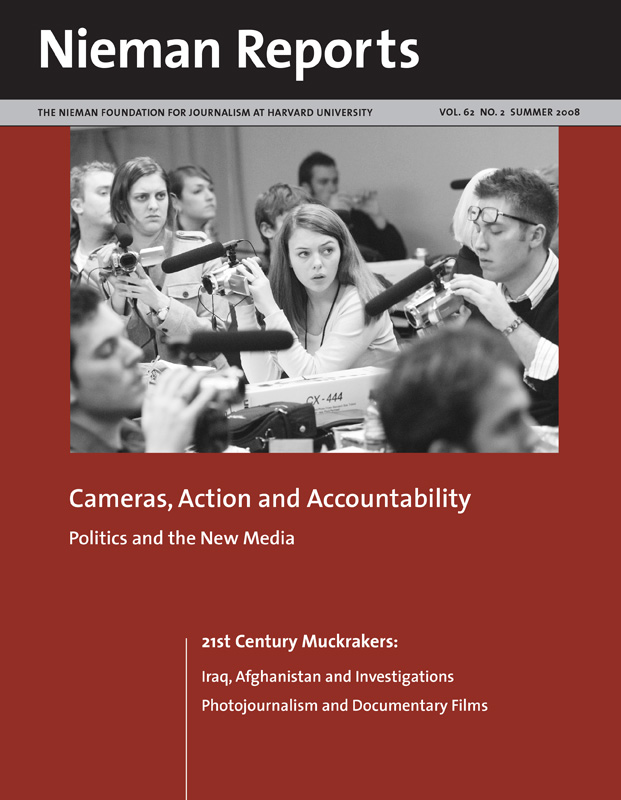On February 21, 2008, the Nieman Foundation hosted its 27th annual Joe Alex Morris, Jr. Memorial Lecture, which honors a leading foreign correspondent and offers the Nieman Fellows and invited guests a time to reflect on the risks of being a journalist in a dangerous world. In his role as a correspondent for several news organizations, Morris invested his life’s work in reporting from the Middle East. As Nieman Curator Bob Giles said in his introductory remarks, “He knew the people, the languages, the history and the culture, understood the political nuances and the risk of covering wars, revolutions, coups and upheavals.” Morris died in Tehran, Iran in February 1979, after being hit by a bullet while sitting in a second-floor window observing a battle between forces loyal to the Shah of Iran and those committed to Ayatollah Khomeini during the Iranian Revolution. He was there in his role as the Middle East bureau chief for the Los Angeles Times and was 51 years old when he died. In 1981 members of Joe’s family, his classmates from Harvard, and his journalistic colleagues established this forum to honor an American overseas correspondent or commentator on foreign affairs.
Tim Golden, a 1996 Nieman Fellow, delivered this year’s Joe Alex Morris, Jr. lecture. In his career, Golden has worked primarily as a foreign correspondent, reporting for many years from Latin America, and as an investigative reporter. In recent years, he has focused for The New York Times on issues surrounding the U.S. government’s treatment of prisoners in the campaign against terrorism. Giles described Golden’s work in this way:
Early in 2004, Tim Golden first began reporting on the Bush administration’s secret detention system at Guantanamo; his stories penetrated the controversy behind the treatment of foreign men captured in the fight against terrorism. In 2006, Tim reported on one of the little-known episodes at Guantanamo — the hunger strikes by which more than 100 detainees were protesting their confinement. He broke the story that the government had cracked down on the strikers by strapping them into restraint chairs to forcibly feed them. He then shifted his focus to the failures of one of the military’s longest and most ambitious efforts to prosecute soldiers and officers for abuses, including the deaths of two detainees at a prison in Afghanistan. In making sense of the prosecution’s shortcomings, his reporting provided a level of detail and fairness that impressed even the prosecutors. In a confidential note, one of the lawyers wrote, “Sometimes the truth is not pretty.” Golden followed with a compelling narrative in The New York Times Magazine, entitled “The Battle for Guantanamo,” in which he revealed a struggle between the guards and the prisoners that even many in the Bush administration did not know about.
What follows are edited excerpts from Golden’s lecture.
In the summer of 2002, I went to Spain to do a story about that country’s struggle with terrorism. It was a busy time in the Spanish government’s fight against both al-Qaeda and the Basque militants, and I traveled up to the Basque country to get a sense of its crackdown on the separatist group ETA and its supporters. The Basque region is not one of the more beautiful parts of Spain. Much of it is heavily industrial, which is why it has the country’s highest per capita income outside of Madrid. But after a couple of months covering the intifada in Israel and Egypt, I found myself driving out of San Sebastián into these green, wooded hills and having a bit of a Joe Alex Morris moment — even without the white MG.
I spent an afternoon interviewing people in a small town that was governed by Batasuna, the political party aligned with ETA. It was an eerie place: old men sipping anís at outdoor cafés and young mothers pushing strollers — and the few town councilmen who opposed the separatists scurrying around with bodyguards, afraid for their lives. As I was about to leave, some policemen marched up to the local Batasuna tavern and shut it down on orders from the Madrid government, alleging that it was part of a front company supporting terrorism. After a big protest demonstration, I ended up at this shuttered bar, talking into the night with a bunch of young Basque radicals.
It was not a place that normally welcomed or even allowed in strangers. But I kept hanging out, and these kids kept drinking, and eventually they started to loosen up. On the wall, they had hung photographs of each of the ETA members from the town who had been jailed or killed by the authorities. And all they wanted to talk about was what they called “la represión.”
This anger is a source of great frustration for the rest of Spanish society. The “dirty war” against ETA that these young people were talking about had ended 15 years earlier, when many of them were still in elementary school. Twenty-seven people had been killed, but it was not Chile or Guatemala. And since then, things had changed. The region had gained political autonomy and lots of jobs and good, Basque-language schools. Yet these kids were going on about “the torture” and “the bombings” as though they had taken place the week before. To them, the government’s subversion of the rule of law hadn’t been an aberration; it had been an unmasking. It confirmed everything they had come to believe about the mendacity of the Spanish state.
I have been reminded of the power of that memory as I’ve thought about how we understand the fallout from our own declared “War on Terror.” I don’t mean to suggest any moral equivalency between the Spanish events of the 1980’s and the Bush administration’s counterterrorism campaign; there are enormous differences. But I do think that the Spanish experience shows us how stubborn and slow a democracy can be about working through these sorts of events once they come to light. Perhaps more importantly, it underscores how differently they are absorbed by people who feel they are defending themselves against terrorism and those who see themselves as the victims of that defense.
As the invasion of Iraq approached, many of us wondered whether it would play in our living rooms like the previous Gulf War, as a kind of video-game sequel in which we would see the killing in flashes of light hitting suspicious hot spots. Maybe those expectations help explain the shock that so many young soldiers have suffered by their exposure to the violence in Iraq. But that war has never stinted on scenes of carnage and suffering.
Something very different has happened in our war on terror. Most Americans have seen little of the ground-level realities of that conflict, particularly the treatment of prisoners. Guantanamo and Abu Ghraib and renditions and waterboarding have all made news. But they have done so with only a hint of the immediacy and impact with which they have reached the Middle East, Central Asia, and Europe. Here, with the exception of a few accused 9/11 perpetrators, the prisoners and former prisoners are hardly visible to us. There, some of our former prisoners have become household names.
As journalists, I think we have fallen short in our efforts to come to grips with how the government has fought and is fighting this shadow war. Each week brings new revelations about the conduct of American intelligence agencies and military forces after 9/11. The broad outlines have been emerging for several years, but what we are learning calls into question whether we have acted humanely and in keeping with our core values. It also raises a slew of questions about whether we have acted effectively.
After a period in which some senior administration officials dismissed the notion that American counterterrorism policies might contribute to the radicalization of Islamists, there is no longer much dispute that this struggle is essentially political. And if it is true that we stand a better chance of winning it on Arabic-language television networks than we do on military battlegrounds, well, we are coming late to the game.
It properly frightens some American strategists that images from our offshore prison at Guantanamo have become a kind of digital wallpaper for radical Islamists around the world. It used to be that young jihadi recruits would pass around grainy, samizdat videocassettes of the horrors perpetrated against Muslims in places like Bosnia and Chechnya. I’ve heard former Guantanamo prisoners describe how the rage and shock they felt at watching such films drove them to join the jihad. Now, the same sort of propaganda reaches them on listservs and RSS feeds — and 24-hour satellite news.
Officials at the National Security Council (NSC) and the CIA used to worry that the detention center in Cuba might become its own madrassa, taking in low-level jihadis and turning out hardened holy warriors. Some of that might have happened: More than two dozen former detainees are said by the Pentagon to have gone back to the fight. But that retail concern at the NSC and the CIA went out the window some time ago. Now, some of the same officials argue privately that for every man we continue to hold at Guantanamo, indefinitely and without charge, we risk forging another 100 new jihadis in the countries those prisoners come from.
I believe that if he could, President Bush would close Guantanamo tomorrow. He and his aides understand the damage it has done to our country’s image, particularly in the Muslim world. But the only viable alternative that has been proposed is to move the detainees to the United States under a new system of administrative detention. That would require an agreement with the Democrat-controlled Congress — in an election year, no less. It was never going to happen.
Will it happen next year or the year after? The politics of this issue have swung around like a tetherball. We affirm one day that Americans should not torture and remind ourselves the next day that we mustn’t be soft on terrorism. Within a single day in the Senate last week, we went from a vote to outlaw waterboarding to another authorizing wider government eavesdropping of international telephone calls and e-mails.
These debates have rarely been very substantive or well-informed, but nor are they over. We will revisit them as the politics of the issue shift. And some shifts are almost a certainty, either because of the outcome of the presidential election or because of some shocking new revelation about the mistreatment of prisoners. Or because of a shocking new terrorist attack on American soil.
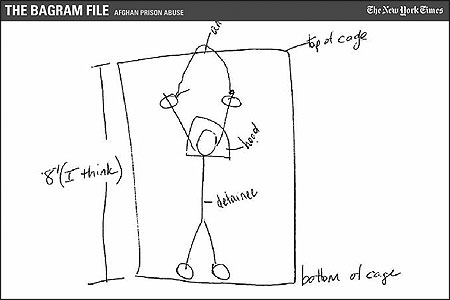
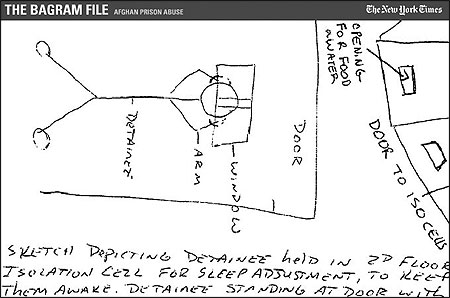
Soldiers’ drawings of how prisoners were treated for the Army’s inquiry into prison abuse. Illustration: Army’s Criminal Investigation, as shown in a New York Times multimedia presentation.
Journalists Start to Tell the Story
The bigger problem for our future may not be the shallowness of the debate so much as the inordinate time it has taken this debate to begin. I don’t hold journalists entirely responsible, but it is not as though we failed to see the challenge coming. Before the Taliban had fallen in Afghanistan, one commentator wrote, “The watchdog role of the press is never more vital than during a national crisis.” Do you remember that line, Bob? It was in your essay introducing the Winter 2001 issue of Nieman Reports.
You weren’t alone. In late November 2001, the recently retired editor of The New York Times, Joe Lelyveld, was given a lifetime achievement award by the Committee to Protect Journalists. He used the occasion to talk about the same sense of duty that Bob described.
“It’s not enough to debate these measures,” Joe said. “It’s our duty to find out what’s really going on, to make our own independent decisions on what we publish and broadcast, with a heavy presumption that publishing and broadcasting are, in a free society, what we exist to do.” He said this role also includes a responsibility “to commit resources to uncovering what’s being unreasonably withheld in the name of national security.”
Among those listening in the ballroom of the Waldorf-Astoria Hotel that night was Lelyveld’s newly installed successor. And the next morning, an order came down from on high that our investigative desk was to immediately produce an article of the genre we had taken to calling “All Known Thought,” or AKT. That meant: Get whatever you can, but whatever you can get has to be in the newspaper by Sunday. This was not a formula for in-depth or groundbreaking reporting, and this particular edict came down the day before Thanksgiving.
Despite these obstacles, a half dozen of my colleagues, led by the formidable Matt Purdy, managed to produce a remarkable story four days later. This was less than two weeks after President Bush had quietly signed the sweeping military order that laid the groundwork for special military tribunals for terror suspects. But Matt got the prospect of a terror detention camp at Guantanamo into the lead of his 3,400-word story, along with an image of the swift, secret military trials that might ensue. “The military tribunals are the boldest initiative in a series of laws and rewritten federal regulations that, taken together, have created an alternative system of justice in the aftermath of Sept. 11,” he wrote.
The most aggressive measures taken by the administration focused on noncitizens. But they also reached into the United States. The Patriot Act had given law enforcement and intelligence agencies new powers to monitor electronic communications and search records. Hundreds of Arab and other Muslim immigrants were being held without charge in American jails. Tens of thousands more were being called in to be fingerprinted and photographed as part of the [Department of Homeland Security’s] “special registration” program.
The day after my colleagues’ story, no less a conservative voice than the columnist William Safire weighed in with a blistering op-ed column entitled, “Kangaroo Courts.” Safire — who had some personal experience with the expansive use of executive power — reported that military lawyers were seething about the decision to set up the special tribunals. In one stroke, he claimed, the Bush administration had “undermined the antiterrorist coalition, ceding to nations overseas the high moral and legal ground long held by U.S. justice.” Former Times’ columnist Anthony Lewis called the presidential military order “the broadest move in American history to sweep aside constitutional protections.”
Important Stories Get Submerged
We don’t take our cues from the op-ed page, but one might have expected the magnitude of these events to set off a scrambling of reporters or a flurry of new assignments. It did not. We and others ran some prescient stories noting complaints about the new policies from out-of-the-loop FBI officials and disgruntled military lawyers. There was some muted coverage of the views of legal and human rights groups. What got more attention was a flurry of stories in the months after 9/11 about how the public and the Congress seemed mostly willing to give the administration wide latitude to combat the new terror threat as it saw fit.
The polls were in fact somewhat ambiguous: One showed that more than half of Americans didn’t like the idea of military tribunals, while eight out of 10 people thought that the administration should seek authorization for such measures from Congress. There were opinion columns about whether we should torture people to get information, but I think mostly those were valid attempts to raise the essential question of how far we as a nation could go without compromising our values.
Soon, though, stories about how we might balance security and civil liberties began slipping deeper inside the major newspapers. In the Times, news that federal immigration courts had begun to hold secret hearings landed on page B-7. A detailed account (although not the first) of the split among Bush administration officials over whether to apply the Geneva Conventions to Taliban and Qaeda prisoners landed on A-12.
There was, of course, a lot going on in late 2001 and early 2002: The hunt for Osama bin Laden. The aftermath of the attacks in New York and Washington. Enron. And it’s easy to question these news judgments with the benefit of hindsight. But it’s also fair to say that anyone who didn’t think there were important constitutional battles in the offing — or that the Bush administration was not intending to make aggressive use of the President’s wartime powers — had not read his military order of November 13th.
Covering the Treatment of Prisoners
Notwithstanding some very good stories by very good reporters, questions about how we were treating our prisoners in this new conflict were not placed at the center of the agenda by major news organizations. In March 2002, Rajiv Chandrasekaran of The Washington Post wrote the first major story showing how the CIA was using Gulfstream jets to fly terror suspects from one country to another for interrogation — the practice known as “extraordinary rendition.” That December, the Post had another excellent front-page story about prisoners being beaten and aggressively interrogated in American custody. It ran the day after Christmas and received little attention.
A month later, my colleague Carlotta Gall went to a remote village in Afghanistan and retrieved the military death certificate for one of two Afghan prisoners who had died within a week of each other in the American detention center at Bagram Air Base. The military had insisted that both men died of natural causes. But the document Carlotta got from the man’s family showed that he had suffered severe trauma to his legs and that his death was listed as a homicide. Even then, the story was held for weeks and rejected several times for the front page. It was finally published on A-14.
Did those editorial decisions reflect the sense of trauma that was still felt in New York and Washington? Or a desire to give the government a wide berth? Maybe in some cases. I can really only speak for my own shop, and the psychology there was complicated. I think it’s fair to say that most of us on the investigative staff did not perceive the same sense of a duty to uncover what was happening that Joe Lelyveld had described.
Still, the bigger problems were our lack of focus and our slowness to react. National security coverage concentrated on the 9/11 plot, the threat of new attacks, the hunt for al-Qaeda. By the start of 2003, pretty much every reporter with the inclination or sources to do stories about the treatment of prisoners in secret detention was largely distracted by Iraq, as were their editors. It was only after the Abu Ghraib scandal broke in May 2004 and the photos appeared that the prisoner issue became a real story.
Another problem was that this was very difficult reporting. We were dealing with what may be the most secretive administration in American history, at its most secretive moment. No one in the government wanted to talk about renditions or interrogations or other treatment of prisoners. The discipline and compartmentalization within the upper reaches of the Bush administration was extraordinary.
When I began working on the detention issue in early 2004, I was not particularly focused on allegations of abuse. I wanted to try to penetrate the opaque process by which this parallel system of justice had been established. I also hoped to test some of the basic claims on which Guantanamo had been founded: that the detainees held there were “the worst of the worst” and that the intelligence information they had given to interrogators had been vital in the fight against terrorism.
It was hard going. Had I not been able to work for months at a time on some of these stories, travel to meet sources face-to-face, and depend on reporting help from colleagues in Afghanistan, Pakistan and Europe, it would have been impossible to make the headway we did. It was time-consuming. It wasn’t cheap. But there was no other way to do it.
One series I’m proud of went back to the two Bagram deaths that Carlotta Gall had reported on in 2003. In the course of trying to get deeper inside what was going on at Bagram, I obtained the Army’s criminal investigative report on the killings. It contained some chilling details about how these two men had died at the hands of their young American captors, most of whom were good, patriotic kids who had been called up from the Army reserves.
The deaths pointed to a larger story about how interrogation rules had been set down and how certain techniques migrated from Bagram and Guantanamo to Iraq. What really made the story, though, was the reporting of my young Afghan colleague Ruhullah Khapalwak, who went back to the village of one of the victims, a young taxi driver named Dilawar, and spoke to his family and friends. [A film based on the Times’s stories, “Taxi to the Dark Side,” won this year’s Academy Award for best documentary.]

New York Times reporter Tim Golden (inset photo) narrates a slide show about what happened to Dilawar at Bagram Air Base in Afghanistan. Dilawar, a slight, 22-year-old taxi driver, was one of two men who died while in detention. His 2002 death was ruled a homicide by the Army medical examiner. Photo by Dilawar’s family.
Changing Priorities in Changed Newsrooms
It’s become almost a foreign correspondent parlor game to lament the passing of an age when the best diplomats and intelligence officers were sophisticated, well-read experts on their regions, people who spoke the languages and knew the leaders. We report scornfully that the CIA has too few capable spies and a dearth of Arabic speakers, or that the FBI’s top counterterrorism jobs have turned over almost every six months since 2001.
But journalists are practically a mirror image of those problems, particularly when it comes to covering national security issues. You’ve heard more than one speaker here talk about the declining number of foreign correspondents employed by major American news organizations. And within those shrinking numbers, there are also fewer correspondents who are willing to devote their lives to building the sort of expertise on a particular region that so many people had 10 or 20 years ago.
It’s not so different in Washington, either. The other day I heard a panel of reporters talking about covering the CIA after 9/11. The estimable Walter Pincus of The Washington Post looked over at the two others there, his colleague Dana Priest and Tim Weiner of the Times, and observed, “Here I am up here with two of the best intelligence reporters in the country and neither of them actually covers the intelligence community anymore.”
Part of that reflects the shifting economics of the profession. Some of the best reporters don’t necessarily want to cover beats, as their predecessors did. They want to take on particular subjects and do bigger stories — often so that they can write books, which may now be a better way to make a living than daily reporting. But part of the problem is also that editors don’t necessarily put this challenge at the top of their agendas.
I don’t mean to suggest that it’s easy. It takes time. It costs money. It takes some determination on everyone’s part to keep pounding away at a subject that readers are not necessarily clamoring to read about. But I do mean to suggest that the solutions are obvious: Make it a priority. Hire more reporters. Give them more time to do deeper, more important stories.
If anyone thinks this enterprise is not precarious, they haven’t been paying attention. Today, there might be 30 national security reporters in all of Washington. If the economics of the industry don’t change, that number will likely decline. I can only think of a few such reporters who are under the age of 40.
That fragility is compounded by the pressures on foreign newsgathering. The fight against militant Islamists is taking place above all outside the United States. We broke the Bagram story because we had Carlotta in Afghanistan. The reason the Post broke the renditions story is that they had a very talented correspondent based in Indonesia after 9/11. Neither of our papers has a bureau there now.
My suspicion is that even if Guantanamo is shut down by a new President — say, within a couple of years — we will be dealing with the problem of how to treat our prisoners for almost as long as this campaign against terrorism continues. We have a military detention center at Bagram that is now twice the size of Guantanamo and continuing to grow. Nearby is another, more secret detention site where, according to the International Committee of the Red Cross, incommunicado detention and harsh interrogations still take place.
The CIA is still out there capturing people and holding them secretly and interrogating them somehow. This isn’t about a prison or a set of interrogation techniques; it’s about a system — some version of which will be in place as long as the fight lasts. Many of us have worried about our creeping blindness to the war in Iraq. Yet by comparison to this global struggle against Islamist militants, the fighting in Iraq is practically in plain sight.
Between the Vietnam War and the current war in Iraq, in what was perhaps the golden age of foreign correspondence for American journalists, we placed a great premium on the physical and moral courage of individual reporters. They would get to the story or uncover something important, often risking their lives — or we might never learn about it. It was often a tenuous business, as we found in the fall of Cambodia and at the Bay of Pigs.
More reporters are risking their lives than probably ever before. Yet I think we also face a different challenge now. This is a moment when what we need most is courage in the executive suites and boardrooms of major news organizations. In the face of excruciating financial pressures, they are going to have to remember the duty that we have as journalists in times of crisis. They are going to have to remember that even if the war in Iraq winds down, we will still be enmeshed in another, global conflict that we need desperately to see.
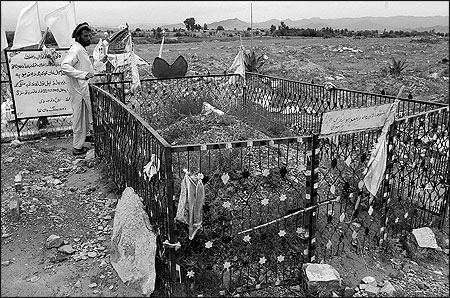
Shahpoor, Dilawar’s eldest brother, visits his grave. “He was a shy man, a very simple man,” Shahpoor said. Photo by Keith Bedford/The New York Times.
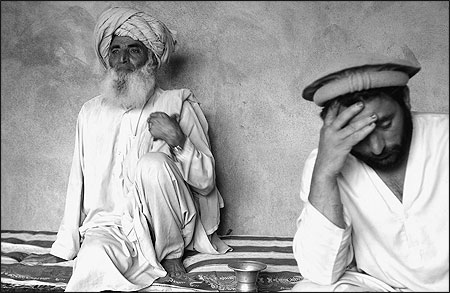
Asaldin, left, with his eldest son, Shahpoor, talks about his other son Dilawar at their home in the town of Yakubi in the district of Khost, Afghanistan. May 2005. Photo by Keith Bedford/Polaris Images.
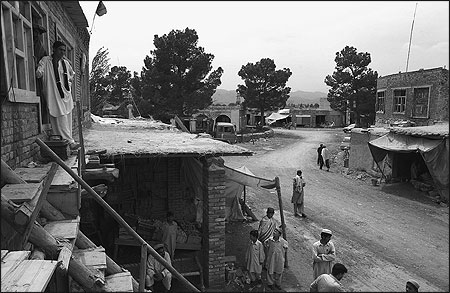
Villagers in Dilawar’s hometown. Photo by Keith Bedford/The New York Times.
A multimedia report by Tim Golden about torture victims at Bagram can be found on The New York Times Web site, www.nytimes.com.


